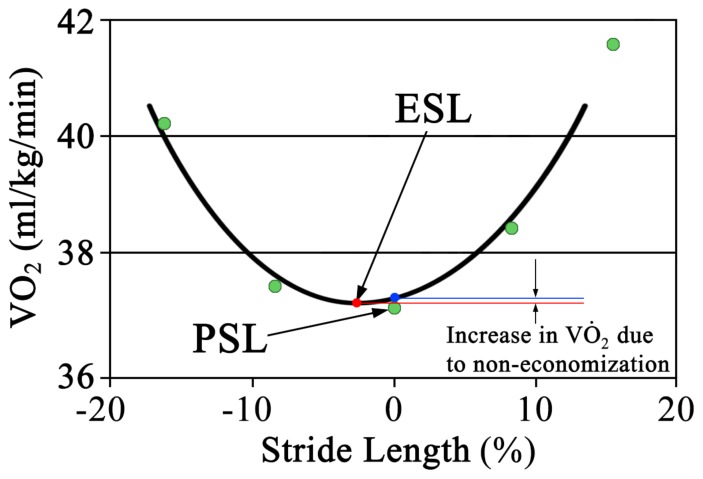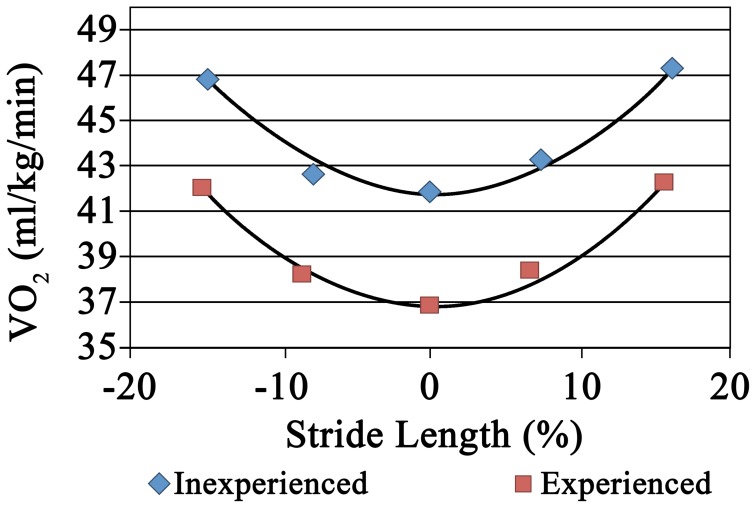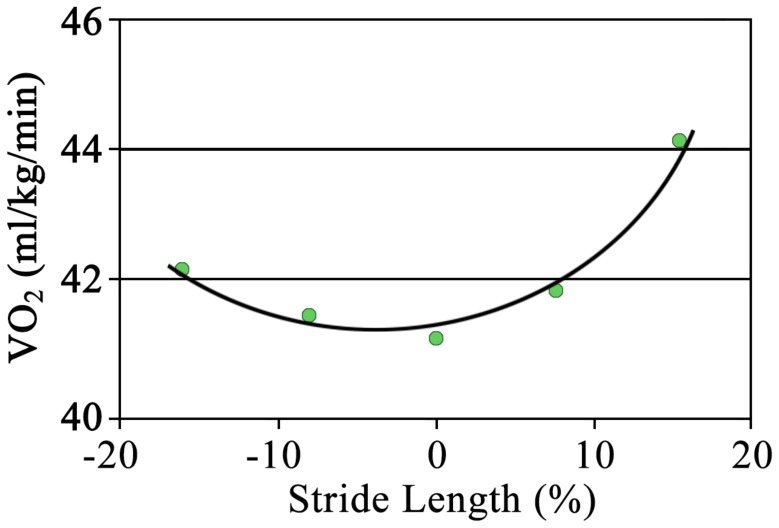Abstract
Experienced runners appear to naturally select a stride length which is optimal for minimizing oxygen uptake. However, whether this ability is naturally built into the human body or whether it is learned through experience has not been previously tested. This study investigated whether inexperienced runners are as capable as experienced runners of self-optimizing stride length to minimize oxygen uptake. Thirty-three subjects (nineteen experienced and fourteen inexperienced) ran for twenty-minutes while preferred and economical stride lengths were measured. A t-test checked for differences between the experienced and inexperienced groups in the percent increase of oxygen uptake due to not running at the most economical stride length. No difference was found between groups with the increase in oxygen uptake due to not being optimized (p=0.47). The average percent increase in oxygen uptake above the most economical for inexperienced and experienced runners was 1.8% and 1.2% respectively. We concluded that inexperienced and experienced runners are equally capable of matching preferred stride length to economical stride length, thus athletes and coaches do not need to alter runner’s stride length when economy is the main concern.
Keywords: Running, economy, leg stiffness, oxygen uptake
INTRODUCTION
Selecting an optimal stride length in distance running affects metabolic cost demonstrated by increases found in oxygen uptake when non-ideal stride lengths are used (5). Well-trained runners naturally select stride rates and lengths that minimize oxygen uptake at distance running speeds (1, 5, 12, 13, 16). A recent study found a lack of optimization of stride frequency among novice and trained runners (6). This was unexpected due to the multiple previous studies showing the ability to self-optimize stride frequency for economy.
Running can be represented as a spring-mass system. While variations exist in the stiffness of this spring between people and across different speeds, for any given situation, a spring constant can be determined (2, 8, 14). This constant is useful in evaluating differences between runners. The natural oscillation of a spring may be what determines preferred stride rate for a given person, running surface, and speed. The stiffness of the leg spring is primarily determined by the reactions of muscles, tendons, and bones to the ground reaction force (7). Assuming the leg spring adjusts to its natural frequency, inexperienced runners should also have the ability to self-economize stride length.
Along with previous studies showing self-economizing of stride length in a non-fatigued state (1, 5, 12, 13, 16), Hunter and Smith showed stride length is self-optimized at the end of a one-hour high intensity run (12). Many of their subjects had changes in preferred stride length (PSL) from the early to late stages of the run. These changes in PSL matched changes in the most economical stride length (ESL). So, whether rested or fatigued, these runners were capable of self-optimizing stride length for economy even when a change is required during the course of the run.
Coaches and athletes often try to manipulate running technique to improve performance. Since experienced runners self-regulate stride length to optimize economy, changing stride lengths will likely result in a greater metabolic cost. If self-economization of stride length is based upon musculoskeletal factors, inexperienced runners should also be able to select their own preferred stride length without modification. On the other hand, self-economization may be something that is learned through running experience. This study aims to determine whether stride self-economization is different between experienced and inexperienced runners (Figure 1). We expect that if preferred stride length is determined by musculoskeletal parameters, inexperienced runners will also self-economize stride length.
Figure 1.
Example of calculating the increase in oxygen uptake. The black curve represents the best fitting second-degree polynomial through the measured data points. The arrows point to the most economical stride length (ESL) and preferred stride length (PSL). The blue line shows the predicted oxygen uptake at PSL while the red points to the oxygen uptake at ESL.
METHODS
Participants
Preferred and economical stride length was measured in 33 subjects (19 experienced and 14 inexperienced). An experienced runner averaged at least 20 miles per week for the past two years. Ten of the experienced runners were intercollegiate distance runners with the same coach, the rest were taken from elsewhere in the university population. Inexperienced runners were defined as never having run more than five miles in one week throughout their lives. These subjects were healthy and active consistently training as swimmers and cyclists.
Risks, benefits, and procedures were explained to each subject prior to participation. An informed consent document was signed by each subject before he/she was allowed to begin. The study was approved by the Brigham Young University Institutional Review Board.
Protocol
Subjects completed a 20-minute preliminary run for treadmill accommodation. They self-selected this preferred pace. During this preliminary run, preferred stride length was calculated by timing 30 strides multiplied by treadmill speed, then dividing by 30. This stride length along with plus and minus 8 and 16% of this length were used during the preliminary run to practice running at these non-preferred lengths. These percentages of modified stride lengths were used as a results of pilot testing and matching a previous study that used similar methodologies (12). Runners maintained each non-preferred stride length for 2 minutes. The pace averaged 3.66 m/s for the experienced group and 3.04 m/s for the inexperienced group.
The data collection run was completed at the pace determined during the preliminary run. A metabolic cart (Parvo Medics, Salt Lake City, UT) reported average oxygen uptake for every 15 seconds during the entire run. Calibration took place before each use using known gases.
Preferred stride length was measured during the fourth minute of the data collection run with the help of a customized computer program (Microsoft Visual Basic, Microsoft Corp, Seattle, WA). The investigator would click the mouse button every time the right foot came in contact with the treadmill for twenty strides. The computer would then divide 20 strides by the amount of time needed to complete 20 strides to get the stride rate. Dividing treadmill speed by stride rate provided stride length. Following the data collection run, video was used to confirm preferred and manipulated stride lengths throughout the run. All preferred measurements taken while running were within 1% of the calculation from video. After the fourth minute of the data collection run, subjects ran the five different stride lengths for two minutes each in random order. The second minute of each stride was used for oxygen uptake measurements. This timeline was determined from previous research and pilot testing (12). The entire run was a continuous 14 minutes long.
Following the first five minutes of running, economical stride length was measured by having subjects run with five different stride lengths (preferred and plus and minus 8 and 16% of preferred). A computer based metronome helped maintain these stride lengths for two minutes each. The minimum value of a best-fit second-degree polynomial with oxygen uptake (taken from the final minute of each stride length) as a function of stride length was used to determine ESL (Figure 1). Oxygen uptake at PSL was calculated using the same polynomial.
Statistical Analysis
An independent t-test was used to compare differences between experienced and inexperienced runners in how much more oxygen was required to maintain preferred stride length over economical stride length. The resulting means, standard deviations, and samples sizes were used to determine statistical power.
RESULTS
No difference was found between experienced and inexperienced groups for the extra oxygen required for non-optimization of stride length (Table 1, t=1.49, p=0.23). The average percent increase in oxygen uptake required for non-optimization are reported in Table 1. Statistical power of 0.80 existed for the ability to detect a difference of 2.73%. The average oxygen uptakes while running at preferred stride length for inexperienced and experienced runners were 33.6 ml/kg/min and 39.4 ml/kg/min respectively (Figure 2).
Table 1.
Increases in VO2 due to deviation from economical stride length (p=0.23).
| Experienced | Inexperienced | |
|---|---|---|
| Increase in VO2 (%) | 1.2±0.03 | 1.8±0.03 |
| Difference between PSL and ESL | 3.47±0.04 | 5.43±0.04 |
Figure 2.
Average data points for inexperienced and experienced runners.
Although all subjects were considered optimized for economy in terms of stride length, the steepness and shape of each curve varied from subject to subject. The most commonly observed curves showed equally increased oxygen uptake for shorter or longer strides. Other curves had small increases in oxygen uptake with shorter strides, but large increases with longer strides (Figure 3).
Figure 3.
A common outcome where shorter strides were less detrimental to running economy than longer.
DISCUSSION
Inexperienced runners are equally capable of optimizing stride length for minimal oxygen uptake as experienced runners. The small non-significant average difference and the sufficient power to detect a difference of 2.73% provided confidence that if any difference exists between experienced and inexperienced runners, it is quite small. Our results do not match with De Ruiter’s findings. Different running paces might alter how impactful a slight deviation between PSL and ESL will be. Our study included metronome use during the PSL testing whereas De Ruiter’s did not. We chose to use the metronome during PSL in case there is an effect on metabolic cost due to focusing on the cadence. We also looked at metabolic cost by time rather than distance. Taking both studies into consideration, there is still a need to determine the specific conditions where inexperienced runners differ from experienced. One thing that is not conflicted between the studies is that PSL may change with experience of running. Many factors may lead to this including changes in: stride length, vertical oscillation, leg stiffness, body segment parameters, preferred joint angles, and preferred body positions (15).
While no relationship between leg stiffness and running economy was investigated, this study supports the idea of the body acting as a mass-spring system (7, 8, 11). Stride frequency is closely connected to leg stiffness (8). Springs have a resonant frequency at which they will oscillate. This resonant frequency is determined by the stiffness and the applied mass with the equation:
| Equation 1. Natural frequency of a spring. |
Where fn is the resonant frequency, k is the stiffness of the spring, and m is the mass. The stiffness depends upon the properties and reactions of the tissues that act as a spring, while the average applied force depends upon the flight time and ground contact time. Heise and Martin (11) showed that the less economical runners possess a more compliant running style during ground contact. Although the stiffness may be different for a trained versus untrained group, assuming the untrained is less economical, the current stride a runner uses appears to be the most economical for their conditioning. Over time it is reasonable to assume the stiffness and the mass may change through training, but at any given time the stiffness should lead to a preferred stride rate and length that is also the most economical.
The steepness and shape of each curve varied from subject to subject. Some were capable of using stride lengths substantially different than preferred without large increases in oxygen uptake. In a few cases, shorter strides than preferred were less detrimental than longer strides within a given subject (Figure 3). For most subjects, varying stride length slightly had a small effect on oxygen uptake. However, the further away from preferred a subject would go, oxygen uptake increased dramatically. Shorter strides result in smaller peak forces and range of motion at the hip and knee (10). Some runners can handle a shorter stride without large increases in metabolic cost. If decreased forces and range of motion are desired for someone, they may be able to accomplish that with minimal increase in effort. However, there is still a greater perceived exertion when choosing shorter strides (10). When using a shorter stride, more repetitions will be required if a run of equal length is completed. However, the extra repetitions may not be detrimental since patellofemoral load is considerably less when using a shorter stride (17). However, whenever running technique is modified, stresses on the body are altered and care should be taken if one has a desire to make this kind of modification.
As an inexperienced runner becomes experienced, changes may occur in endurance capacities, running economy, body weight, body composition, muscle strength, and muscle power (3, 4, 9). Thus, over time, changes in stride length may occur. However, at any point of the spectrum from inexperienced to experienced, the chosen stride length is probably ideal for economy.
Inexperienced and experienced runners may not need to manipulate stride length to economize their running technique. This study is only applicable to running speeds used here. When maximizing running speed over short distances is the main concern, runners may choose to sacrifice some economy to increase top speed. This study only investigated relatively slow running speeds. More consideration and experimentation should be completed to determine how to optimize technique for maximizing running speed.
REFERENCES
- 1.Anderson T. Biomechanics and running economy. Sports Med. 1996;22(2):76–89. doi: 10.2165/00007256-199622020-00003. [DOI] [PubMed] [Google Scholar]
- 2.Arampatzis A, Bruggemann GP, Klapsing GM. Leg stiffness and mechanical energetic processes during jumping on a sprung surface. Med Sci Sports Exerc. 2001;33(6):923–931. doi: 10.1097/00005768-200106000-00011. [DOI] [PubMed] [Google Scholar]
- 3.Bengt S. Physiological effects of physical conditioning. Med Sci Sport. 1969;1(1):50–56. [Google Scholar]
- 4.Burniston JG, Hoffman EP. Proteomic responses of skeletal and cardiac muscle to exercise. Expert Rev Proteomics. 2011;8(3):361–377. doi: 10.1586/epr.11.17. [DOI] [PMC free article] [PubMed] [Google Scholar]
- 5.Cavanagh PR, Williams KR. The effect of stride length variation on oxygen uptake during distance running. Med Sci Sports Exerc. 1982;14(1):30–35. doi: 10.1249/00005768-198201000-00006. [DOI] [PubMed] [Google Scholar]
- 6.de Ruiter CJ, Verdijk PW, Werker W, Zuidema MJ, de Haan A. Stride frequency in relation to oxygen consumption in experienced and novice runners. Eur J Sport Sci. 2014;14(3):251–258. doi: 10.1080/17461391.2013.783627. [DOI] [PubMed] [Google Scholar]
- 7.Farley CT, Blickhan R, Saito J, Taylor CR. Hopping frequency in humans: a test of how springs set stride frequency in bouncing gaits. J Appl Physiol. 1991;71(6):2127–2132. doi: 10.1152/jappl.1991.71.6.2127. [DOI] [PubMed] [Google Scholar]
- 8.Farley CT, Gonzalez O. Leg stiffness and stride frequency in human running. J Biomech. 1996;29(2):181–186. doi: 10.1016/0021-9290(95)00029-1. [DOI] [PubMed] [Google Scholar]
- 9.Francis P, Mc Cormack W, Caseley A, Copeman J, Jones G. Body composition changes in an endurance athlete using two different training strategies. J Sports Med Phys Fitness. doi: 10.23736/S0022-4707.16.06365-9. In Press. [DOI] [PubMed] [Google Scholar]
- 10.Heiderscheit BC, Chumanov ES, Michalski MP, Wille CM, Ryan MB. Effects of step rate manipulation on joint mechanics during running. Med Sci Sports Exerc. 2011;43(2):296–302. doi: 10.1249/MSS.0b013e3181ebedf4. [DOI] [PMC free article] [PubMed] [Google Scholar]
- 11.Heise GD, Martin PE. “Leg spring” characteristics and the aerobic demand of running. Med Sci Sports Exerc. 1998;30(5):750–754. doi: 10.1097/00005768-199805000-00017. [DOI] [PubMed] [Google Scholar]
- 12.Hunter I, Smith GA. Preferred and optimal stride frequency, stiffness and economy: changes with fatigue during a 1-h high-intensity run. Eur J Appl Physiol. 2007;100(6):653–661. doi: 10.1007/s00421-007-0456-1. [DOI] [PubMed] [Google Scholar]
- 13.Martin PE, Morgan DW. Biomechanical considerations for economical walking and running. Med Sci Sports Exerc. 1992;24(4):467–474. [PubMed] [Google Scholar]
- 14.McMahon TA, Cheng GC. The mechanics of running: How does stiffness couple with speed. Journal of Biomechanics. 1990;23(S1):65–78. doi: 10.1016/0021-9290(90)90042-2. [DOI] [PubMed] [Google Scholar]
- 15.Moore IS. There an Economical Running Technique? A Review of Modifiable Biomechanical Factors Affecting Running Economy. Sports Med. 2016;46(6):793–807. doi: 10.1007/s40279-016-0474-4. [DOI] [PMC free article] [PubMed] [Google Scholar]
- 16.Williams KR, Cavanagh PR. Relationship between distance running mechanics, running economy, and performance. J Appl Physiol. 1987;63(3):1236–1245. doi: 10.1152/jappl.1987.63.3.1236. [DOI] [PubMed] [Google Scholar]
- 17.Willson JD, Ratcliff OM, Meardon SA, Willy RW. Influence of step length and landing pattern on patellofemoral joint kinetics during running. Scand J Med Sci Sports. 2015;25(6):736–743. doi: 10.1111/sms.12383. [DOI] [PubMed] [Google Scholar]





